The hydrangea is a deciduous shrub with mature dimensions ranging from dwarf to tree-sized that boasts showy flower heads in an array of forms and hues.
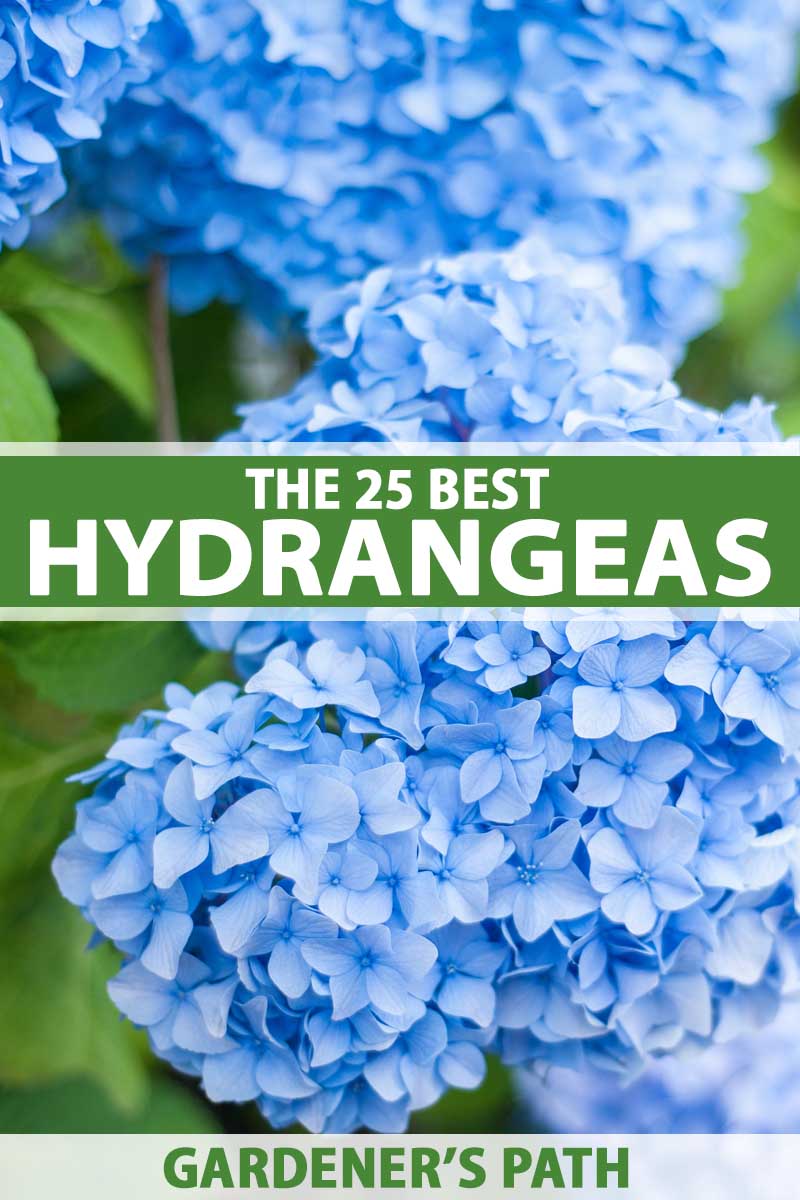
We link to vendors to help you find relevant products. If you buy from one of our links, we may earn a commission.
In this article, you will find 25 of our favorite hydrangeas for containers and gardens in your outdoor living space.
Here they are:
The 25 Best Hydrangeas
Big Leaf Hydrangeas
Big leaf hydrangea, H. macrophylla, is a large species that encompasses three main groups: lace cap, mophead, and mountain.
Lace Cap
Lace caps differ from the classic round ball of flowers that has become synonymous with the word hydrangea.
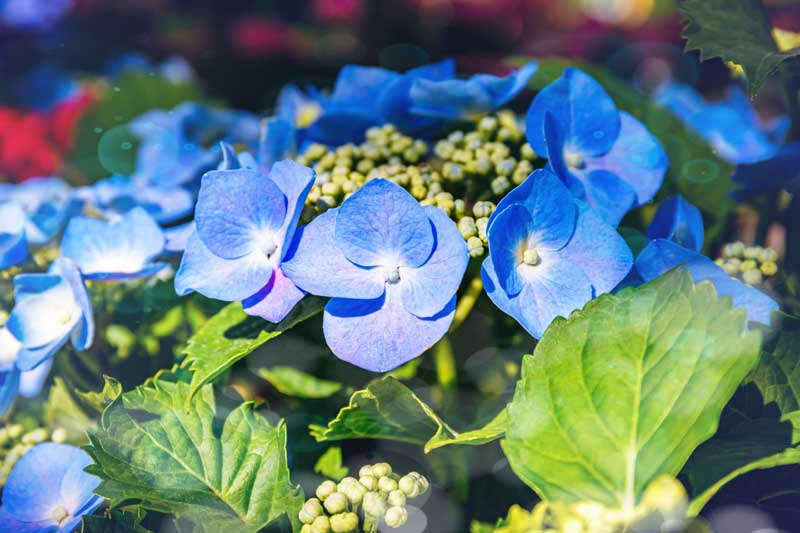
It has a flattened “corymb” of showy blossoms surrounding a center of small buds. This species is well-suited for USDA Hardiness Zone 6 and above. Here are two you’re sure to love:
1. Cherry Explosion
With H. macrophylla ‘Cherry Explosion’ you get cherry pink/red blossoms surrounding a center of pale pink buds that burst into tiny stars.
They may tend toward lavender in more acidic soil. An excellent choice for containers and borders, this compact beauty reaches two to three feet tall in Zones 4 to 9, where it prefers full sun to part shade.
This shrub is appreciated for being able to tolerate cold. It blooms on both old and new wood, and with deadheading, puts on a showy display from spring into fall, when its leaves darken to burgundy.
It has an average growth rate, and is useful as a tidy, low-profile hedge plant.
Plants are available from Nature Hills Nursery.
2. Double Delights ‘Wedding Gown’
Part of the H. macrophylla Double Delights™ series, ‘Wedding Gown’ has a flattened “corymb” flower head with a double ring of impressive blossoms surrounding a double-bud center.
Suitable for Zones 5 to 9, it’s a compact two to three feet tall at maturity, making it a suitable candidate for large container gardening.
Double Delights™ ‘Wedding Gown’
This type prefers light shade. It blooms on both old and new growth, so with deadheading, it should bloom from spring through to fall.
Its growth rate is average, and the white color is not affected by soil acidity.
‘Wedding Gown‘ is available from Plants by Mail.
3. Endless Summer ‘Twist-n-Shout’
Endless Summer® ‘Twist-n-Shout,’ aka H. macrophylla ‘PIIHM-I’ is a blue lace cap that tends toward pink in less acidic soil and reaches a medium stature of three to five feet tall.
It’s called “endless” or “reblooming” because it produces flowers on both old and new wood from summer through to frost, facilitated by deadheading.
Endless Summer® ‘Twist-n-Shout’
This type exhibits outstanding heat and cold tolerance in Zones 4 to 9. It likes a bit of sun and grows at an average rate.
Use it as a specimen planting, to create a hedge of moderate height, or in large containers.
Plants are available from Nature Hills Nursery.
Mophead
The mophead is what most people picture when talking about hydrangeas. They have fluffy balls of blossoms in shades of blue, pink, or purple.
They are pH sensitive and tend to be pinker in alkaline soil and bluer in acidic soil. Flowers bloom on old wood.
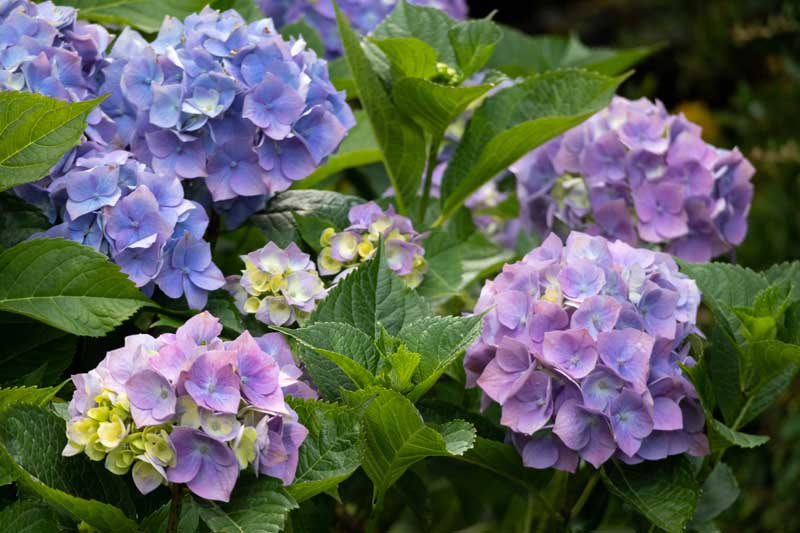
This type grows best in Zones 5 to 11. You may need to provide winter protection like burlap, a covering of mulch, or a sheltered location in Zone 5.
Popular varieties include:
4. Big Daddy
With enormous flower clusters that measure from 12 to 14 inches across, H. macrophylla ‘Big Daddy’ is a fast-growing variety that is either pink or blue depending upon soil acidity.
Its mature height is between five and six feet. From early summer to fall, it puts on a show, blooming on both old and new wood, facilitated by deadheading.
Suited to Zones 6 to 9, this heat-tolerant variety tolerates full sun in cooler regions, and benefits from partial shade in warmer climes.
Consider pruning it like a dwarf tree for a single specimen planting, or mass several for an island of fluffy, pastel color.
Plants are available from Nature Hills Nursery.
5. Cityline Paris
H. macrophylla Cityline® Paris is one of the Cityline® series of dwarf plants with smaller-stature flowers for Zones 5 to 9. Its color is deep pink/red in alkaline soil and tends toward purple in acidic.
Mature height is just one to two feet, with no pruning necessary.
If you’ve got a city patio, this is your dream container plant. In gardens, it makes a friendly, low-profile hedge or border plant.
This plant grows at an average rate and blooms on old wood from early through late summer. It prefers full to part sun, resists mildew, and tolerates salt.
Plants are available from Burpee.
6. Edgy Hearts
A sweetheart of a compact shrub, H. macrophylla ‘Horheart’ aka Edgy® Hearts features unique pink petals edged with white that resemble hearts and combine to form 10-inch flower heads.
In more acidic soils, they tend toward blue. Both fade to green.
With a mature height of two to four feet, this is a perfect candidate for containers, hedges, or specimen plantings in Zones 5 to 9.
This type prefers a location with full to part sun, where it can grow at an average rate. Blossoms form on old wood from early to late summer.
Plants are available from Nature Hills Nursery.
7. Endless Summer ‘The Original’
The first in the Endless Summer® series, this re-blooming type sets buds on both old and new wood for summer to fall flowers.
It likes full sun and exhibits better cold hardiness than many cultivars. This type tops out at a modest three to five feet, for the perfect specimen planting.
Endless Summer® ‘The Original’
This is a pH sensitive variety that may have blossoms that are blue or pink, depending on the soil, in Zones 4 to 9.
It grows at an average rate and benefits from deadheading to prolong blooming.
Plants are available from Nature Hills Nursery.
8. Everlasting Revolution
Everlasting® Revolution (H. macrophylla ‘Hokomarevo’) features a virtual palette of colors with an antique appearance as flower heads mature to shades of fuchsia pink or violet blue, accented by lime green.
Everlasting® series plants bloom on both old and new wood for color from spring to fall.
Deadheading encourages reblooming.
This compact style reaches a petite two to three feet, and is an excellent choice for patio containers, hedging, or small garden specimen plantings.
Grow it in Zones 5 to 9 in a location with full sun to part shade, where it can grow slowly.
Plants are available from Burpee.
9. Everlasting Jade
Another in the Everlasting® series, H. macrophylla ‘Hortmaja’ also has an antique appearance like the cottage garden blossoms of a bygone era.
The flowers start out bright green in spring, fade a bit in summer, and become green with red edges in fall. It’s a petite style that tops out at a mere two to three feet, for a pretty pot specimen or garden edging.
In Zones 5 to 9, provide a location with full to part sun, and expect growth at an average rate.
Plants are available from Nature Hills Nursery.
10. Harlequin
The ‘Harlequin’ mophead is an absolute stunner that can be the centerpiece of any perennial flower garden.
Six-inch blooms with pink to lavender florets edged with white bands will ensure that this variety gets center stage. And it does well in part shade, ideal for backyards with large, mature trees.
Harlequins reach three to five feet and grow up to four feet in width. This cultivar does well in Zones 5 to 9 in areas protected from intense full sun.
11. Nikko
H. macrophylla ‘Nikko’ is a classic “Dutch” blue variety that reaches a height of four to six feet. Blossoms tend toward pink in more alkaline soil.
This fast-growing option is well suited to hedging, mass planting, or specimen display.
Best in Zones 6 to 9, this type prefers full sun to part shade.
It blooms on old wood from early to late summer, and its dry blossoms are noted for holding their color well into the fall.
Plants are available from Fast Growing Trees.
12. Tilt-A-Swirl
Tilt-A-Swirl®, aka H. macrophylla ‘QUFU’ is a stunning choice for those gardening in Zones 5 to 9. It’s an especially cold-hardy shrub with vivid color and a long growing season.
Two-tone blossoms in eye-catching lime and magenta bloom on both old and new wood for a color-changing show from summer to mid-fall.
Reaching three to four feet tall at maturity, this is a prime candidate for beds, borders, and containers.
It grows at a slow to average rate and does best with partial shade, because too much sun tends to reduce its color vibrancy.
Plants are available from Nature Hills Nursery.
Mountain
The mountain type, H. serrata, is actually a different botanical species with smaller lace cap-style flower heads and smaller leaves that mimic the larger big leaf varieties.
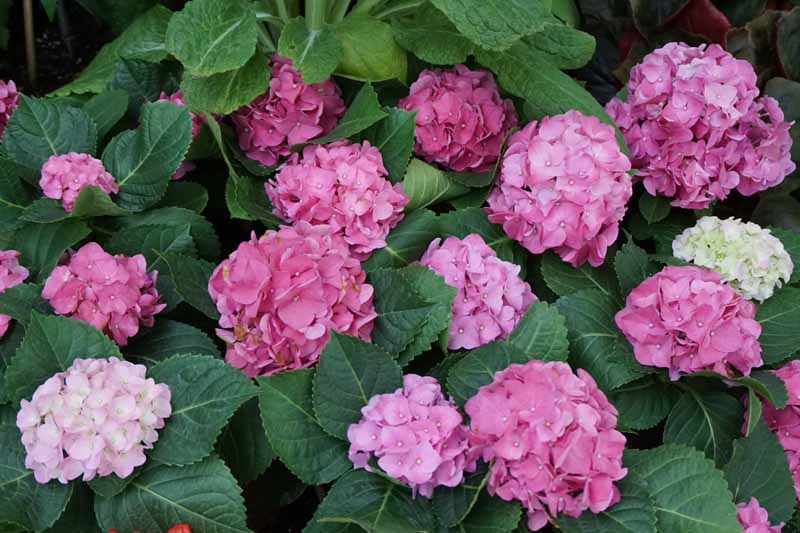
It does well in Zones 6 to 9, and even in Zone 5 with winter protection.
One cultivar to consider is:
13. Tiny Tuff Stuff
If you’ve got a small patio, Tiny Tuff Stuff™, aka H. serrata ‘MAKD’ is the one for you. At a maximum height of 18 to 24 inches, this reblooming blue lace cap will have pink blooms instead in more alkaline soil.
It offers noteworthy cold hardiness and blooms on both old and new wood from early to late summer.
Suited to Zones 5 to 9, this type requires full to part sun. It grows at an average rate and does not need pruning.
Plants are available from Nature Hills Nursery.
14. Pink Dynamo
Pink Dynamo™ (H. serrata ‘JPD01’) is a mountain hydrangea suitable for Zones 5 to 9. It’s a lace cap style with three- to six-inch flower heads that thrives in full sun to part shade.
Each flower head consists of a ring of sterile vivid pink florets with white centers, surrounding a flattened center of fertile pink-purple buds that open to miniature pink-white blossoms.
Not pH sensitive, the flower color of this variety is consistent across all soil types.
Pink Dynamo™ is especially cold hardy and blooms on old wood. The foliage is deep green with a burgundy hue.
Topping out at two to three feet, it has an erect, somewhat rounded, and compact growth habit.
This is an excellent choice for the back of a border, a friendly hedge, a specimen planting, or a large container attraction.
You may find it to be a bit leggy, so low plantings in front may show it to best advantage. Bloom time is from late spring through summer.
Find this variety now at Nature Hills Nursery.
Oak Leaf Hydrangeas
The oak leaf species, H. quercifolia, has leaves that resemble those of oak trees and redden in the fall. Flowers are produced on old wood.
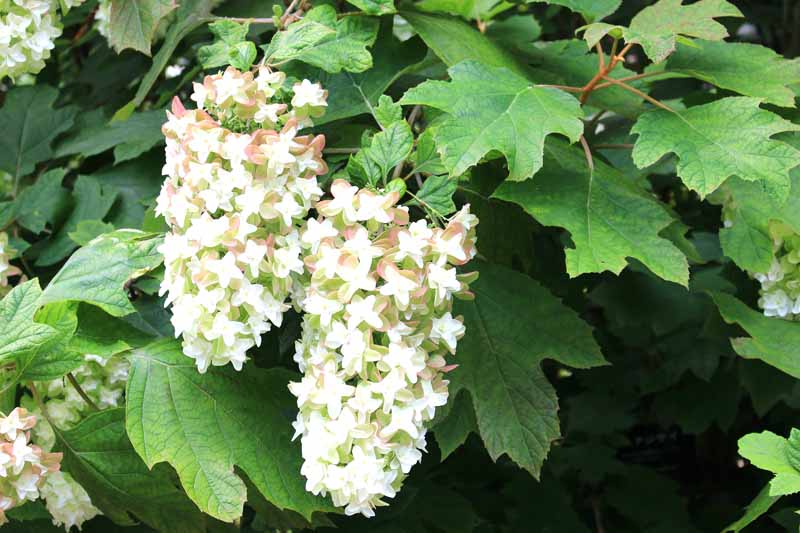
It’s native to the US and has white, conical, single or double blossomed flowers that turn pink with age.
It is cold hardy to Zone 5 with winter protection, and performs best in Zones 5 to 9. A few especially nice cultivars are:
15. Gatsby Pink
Known for its ability to thrive in sun or shade, and in soils of various quality, Gatsby Pink®, aka H. quercifolia ‘JoAnn’ is a winner.
Blooming on old growth, it boasts conical clusters of vibrant pink blossoms in summer that deepen in color in fall, when its leaves turn from green to purple and red.
With mature heights from six to eight feet, this stunner looks great in Zones 5 to 9.
Select a location with full to part sun and expect an average rate of growth.
Consider pruning to a tree-like appearance and using this cultivar to flank a driveway for high visual impact, as well as mass or specimen plantings.
Plants are available from Nature Hills Nursery.
16. Ruby Slippers
A dwarf oak leaf type, H. quercifolia ‘Ruby Slippers’ has conical blossoms that adorn shrubs of three to four feet tall at maturity. They open white and turn ruby red during early to midsummer.
The foliage deepens to reddish-brown and the bark exfoliates attractively in the fall.
This is a fast-growing variety that requires partial shade and does best in Zones 5 to 9. Too much sun may be counteracted with extra water during dry spells.
In addition, shrubs in Zone 5 may benefit from cold-weather protection, like burlap wraps and mulch, because buds form on old wood.
Plants are available from Burpee.
Panicle Hydrangeas
The panicle kind, H. paniculata, has conical blossom clusters called panicles that start out white and fade to pink. Blossoms form on new wood.
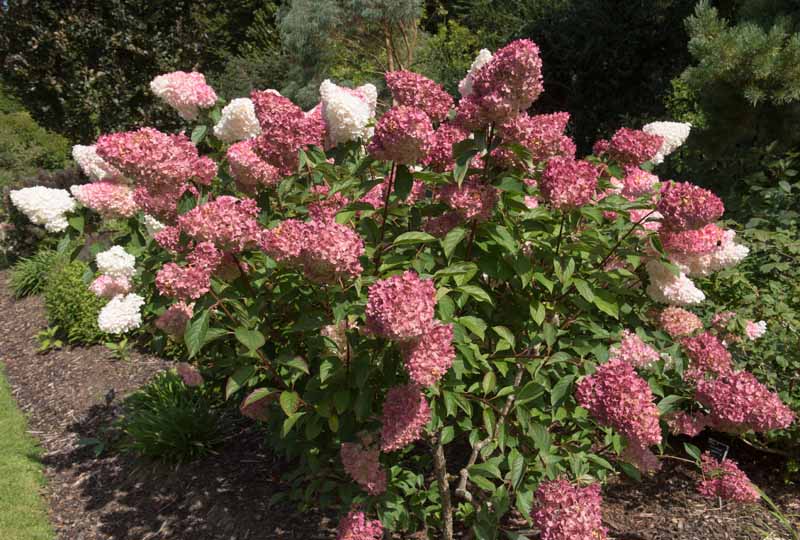
This species grows beautifully in Zones 4 to 8, and possibly Zone 3 with winter protection.
A wide variety of beautiful cultivars are available, including:
17. Berry White
Berry White® (H. paniculata ‘Renba’) sports conical clusters of blossoms that start out white and gradually deepen to dark pink, with a striking two-tone effect during the transition. It’s best suited to Zones 3 to 8.
Colors vary with soil pH and climate, making for interesting hues.
This especially cold, drought, and pollution-tolerant variety blooms on new wood from early summer to mid-fall.
It reaches a height of six to seven feet, for use as a dramatic focal point, individually, or en masse. Provide a location with full sun and anticipate an average rate of growth.
Plants are available from Nature Hills Nursery.
18. Bobo
Bobo® (H. paniculata ‘ILVOBO’) is a dwarf variety with white, conical flower heads. There are so many, and they are so large, that they make the bush look one giant, fluffy flower.
It reaches a compact height of two to three feet, making it a solid choice for container gardening and low-profile hedging.
This fast grower requires full sun to part shade. It blooms on new wood from midsummer to fall.
Plants are available from Nature Hills Nursery.
19. First Editions Vanilla Strawberry
From creamy white to pink and red, the cone-shaped blooms of H. paniculata ‘Renhy’ are sure to delight.
They are not pH sensitive and put on an impressive show from summer into fall. And as they fade, they add interest to the early winter garden.
First Editions® ‘Vanilla Strawberry’
At a mature height of six to seven feet tall, this makes an attractive specimen or hedging plant that provides vertical interest.
Provide full sun to part shade for this color-changing attraction.
Plants are available from Fast Growing Trees.
20. Little Quick Fire
Little Quick Fire® (H. paniculata ‘SMHPLQF’) is a dwarf variety for Zones 3 to 8 noted for its cold tolerance. Its upright, cone-shaped blossoms start out white and deepen to pink and red.
It’s not pH sensitive, and blooms on new wood from early summer into fall.
At a modest three to five feet at maturity, this kind offers versatility, performing equally well in large containers, beds, borders, hedges, and mass plantings.
Choose a location with full sun where this fast grower can take off.
Plants are available from Nature Hills Nursery.
21. Pee Gee
If you’re looking for one of the largest varieties, you’ll love ‘Pee Gee,’ H. paniculata ‘Grandiflora.’ With a mature height of between 10 and 20 feet, you may leave it full, or prune it to form a single-stemmed tree.
It thrives in Zones 3 to 8.
Select a location with full sun to part shade for this fast-growing giant. You’re sure to love its conical clusters of blossoms that grow on old wood and reach between 12 and 18 inches across.
They start out white and deepen to pink from midsummer into fall, for a gorgeous addition to the landscape.
Plants are available via Nature Hills Nursery.
Smooth Hydrangeas
The smooth type, H. arborescens, produces white “snowballs” that may reach a foot in diameter, and is often called a snowball bush. Flowers grow on new wood.

This species prefers a somewhat sunny location and thrives best in Zones 4 to 9. You can read about growing it here.
Some varieties to consider are:
22. Annabelle
If you remember a hydrangea bush from your childhood, this may be the one.
This is known as the classic “snowball” in my locale, with its white, fluffy flower heads ranging from eight to 12 inches across.
This US native shrub grows well in Zones 3 to 9. It is very cold tolerant.
The best location for this shrub is one with full to part shade. It flowers on new wood from early summer to fall, and can withstand a good bit of pruning.
The maximum height at maturity is three to five feet, making it a versatile addition to beds, borders, and containers.
Note that it does tend to get a bit floppy and may require staking.
Plants are available from Fast Growing Trees.
23. Incrediball
H. arborescens Incrediball® is a series of summer bloomers that boast heavy blossoms up to 12 inches across. It starts out lime green, transitions to white, and then back to green again.
Flowers open on new wood. It has sturdy branches that are not prone to drooping.
Suited to Zones 4 to 9, this one requires full sun to part shade. It is a US native shrub with an average growth rate.
Plants are available from Fast Growing Trees.
24. Invincibelle Limetta
Invincibelle Limetta® is a dwarf stunner in the Invincibelle® series is a summer bloomer that starts out green, turns white, then back to green.
It reaches a petite height of only 30 to 36 inches. Display it in containers or use it to create a friendly hedge.
Cultivate this little lovely in Zones 3 to 9. Choose a location with full sun to part shade. It grows at an average rate.
Plants are available from Nature Hills Nursery.
Climbing Hydrangeas
The climbing species, H. anomala subsp. petiolaris, is a slow-growing, long-lived vine that may exceed 50 feet over the years.
Train it along a fence or up a trellis, or let it meander as a unique flowering ground cover.
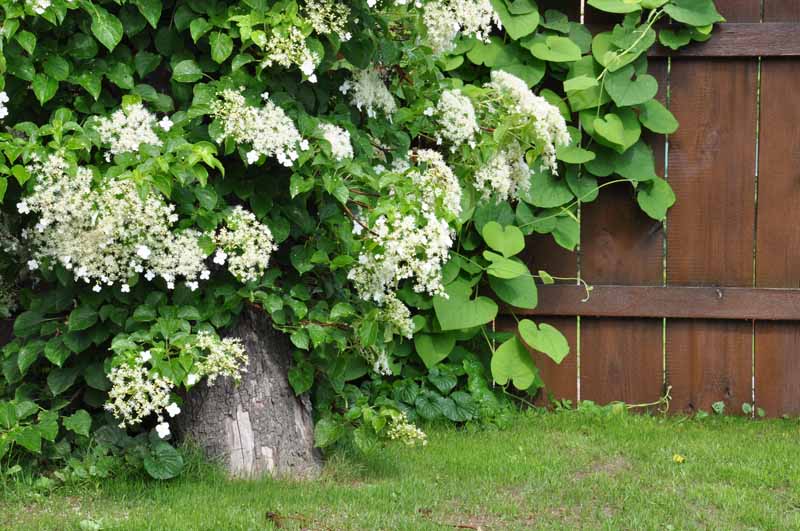
Fragrant flattish “corymb” flower heads that bloom in June resemble small white lace caps. This species is ideal for Zones 4 to 8.
25. Petiolaris
H. anomala subsp. petiolaris is a vine variety with fragrant white flowers that resemble small lace caps. It is a slow-growing plant that takes several years to flower.
Anticipate at least 30 feet of growth, and plan to provide support. Keep in mind that the vines may leave marks where they cling.
This type grows in Zones 4 to 8 and blooms on old wood from late spring to early summer. It benefits from winter protection like burlap and mulch in cold regions.
It grows in full shade, but flowers better with some sun. Some pruning may be required to keep it manageable, and it is somewhat drought tolerant.
Many climbing types are sold without mention of a particular cultivar. They generally have solid green leaves.
Monrovia used to offer a ‘Miranda’ variety that featured variegated green, white, and yellow leaves, but it hasn’t been available for several years.
A Profusion of Memorable Blooms
And there you have them – 23 spectacular hydrangeas to love in your landscape.
For varieties that are pH sensitive, apply garden lime to your soil for pinker shades, or a soil acidifier for bluer tones.

My favorite hydrangea story is about some relatives that grew two “snowball bushes,” as they’re often called here in the Philly suburbs.
When the kids were small, they noticed that the one in the backyard bloomed when it was time for school to get out for the summer, and the one in the front yard, when it was time to go back to school again.
Now it’s your turn to feature these cottage garden charmers in your outdoor living spaces and create happy memories of your own!
Be sure to consult our companion article on how to grow hydrangeas for all you need to know to ensure successful cultivation.
If you enjoyed this article, you’re sure to like our other hydrangea growing and care guides, such as:
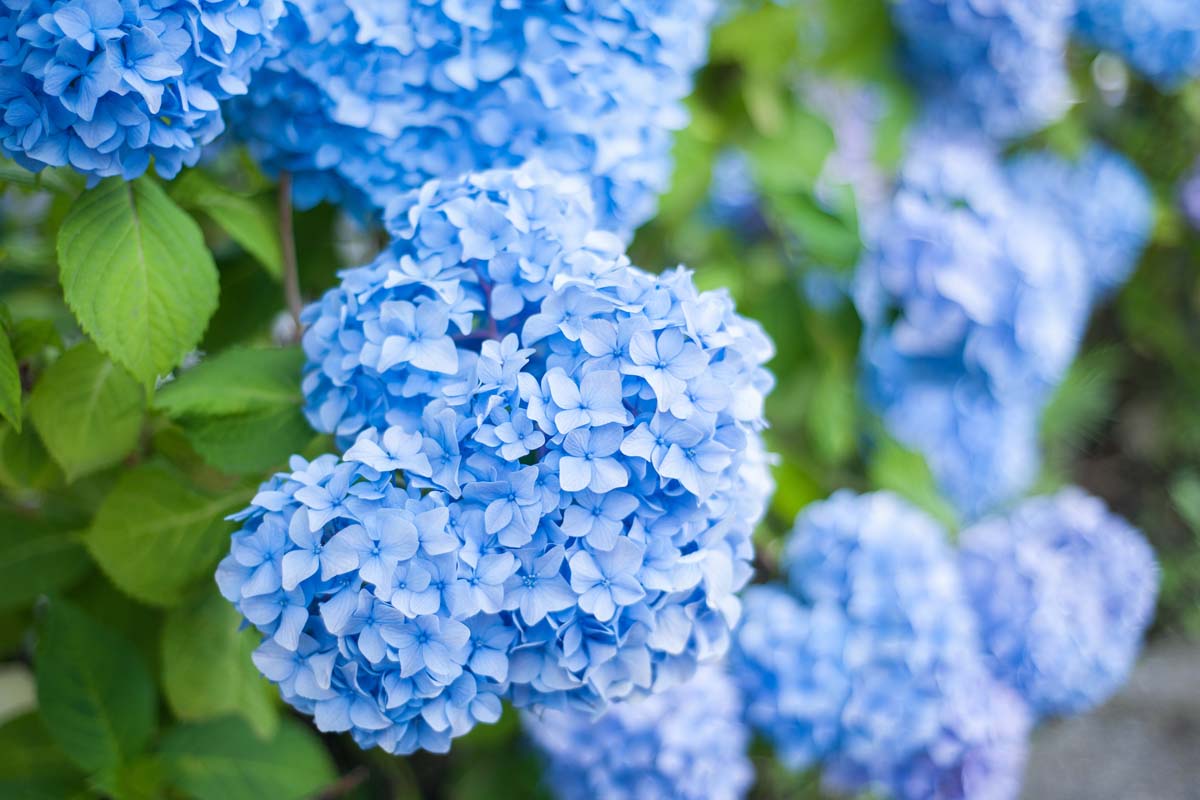
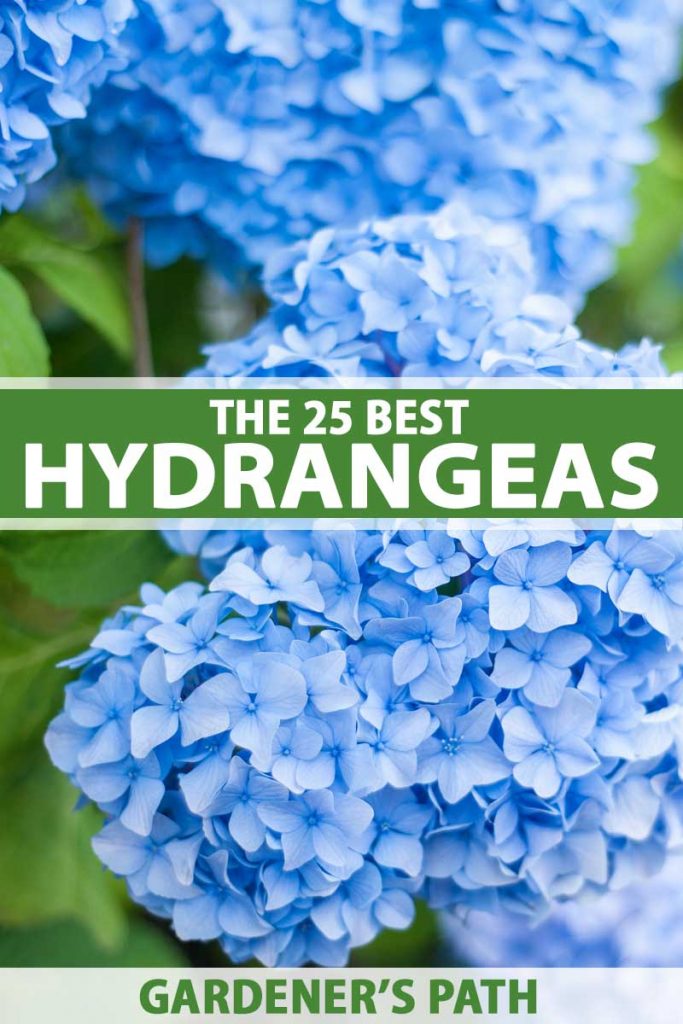
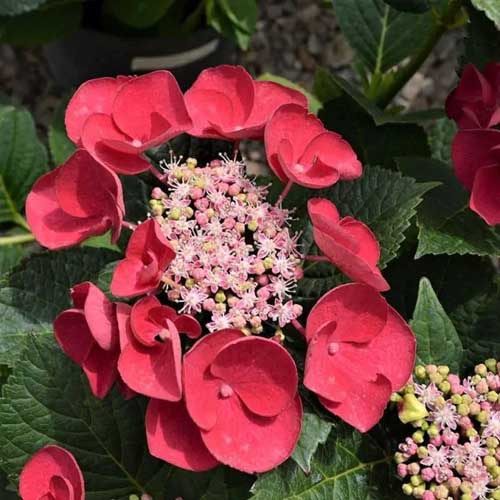
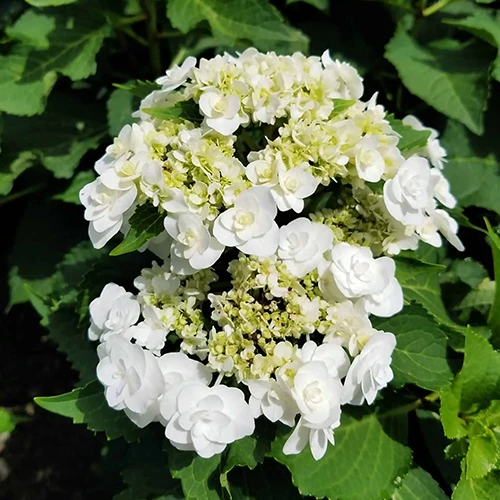
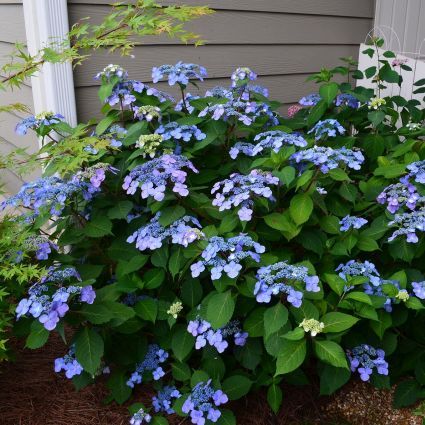
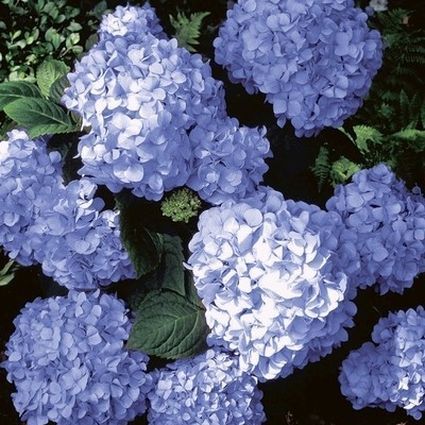

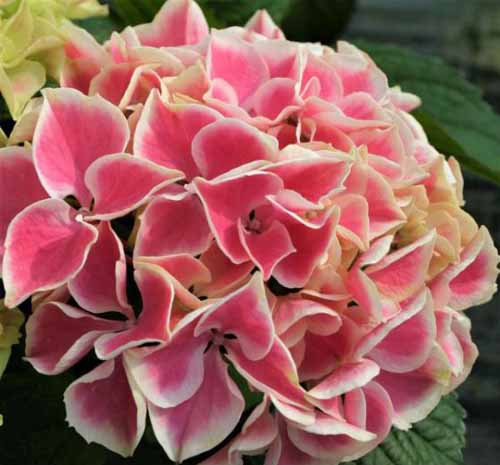

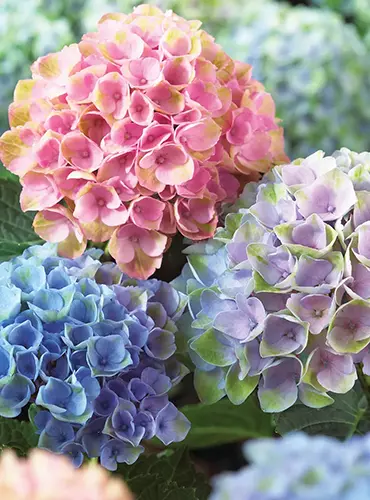
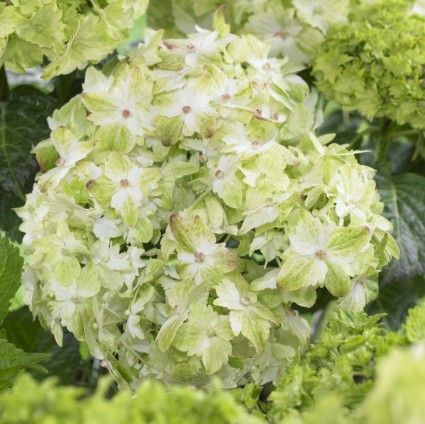

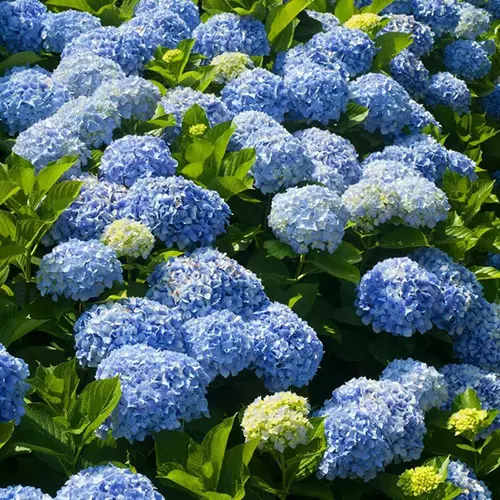
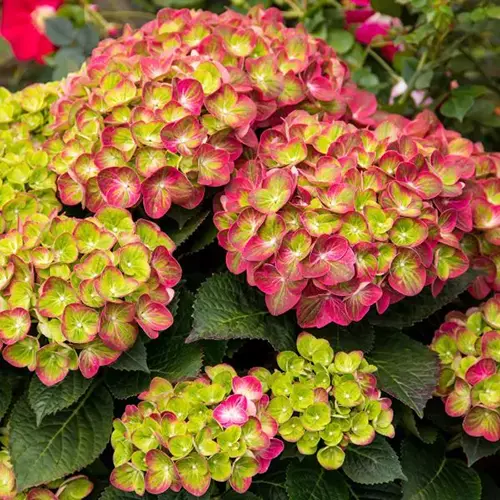
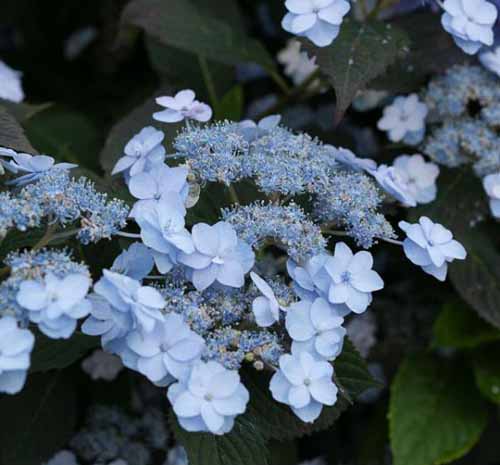
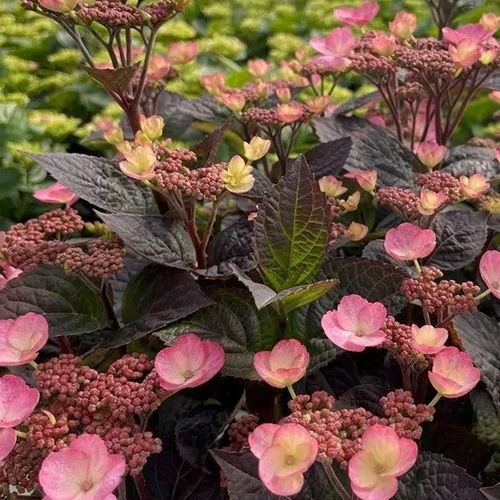
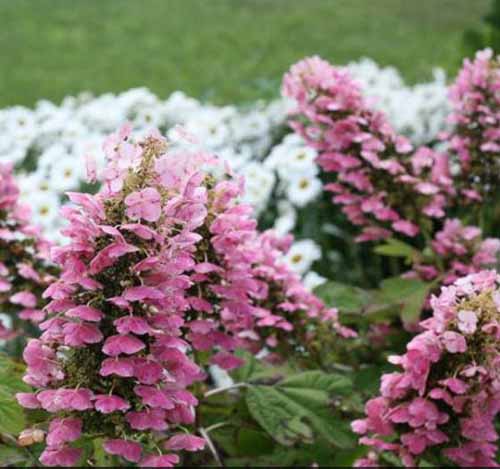
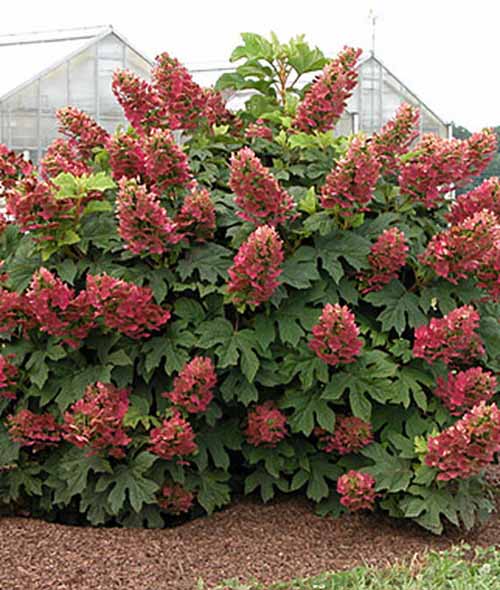

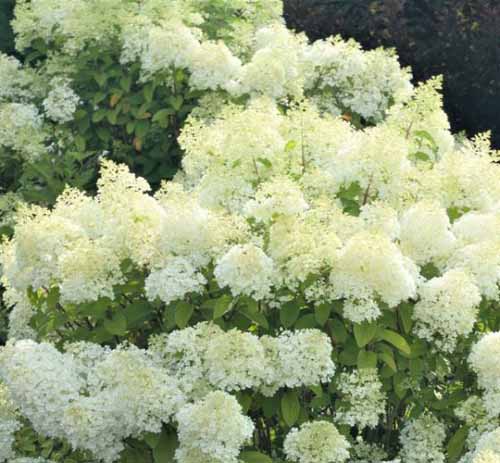

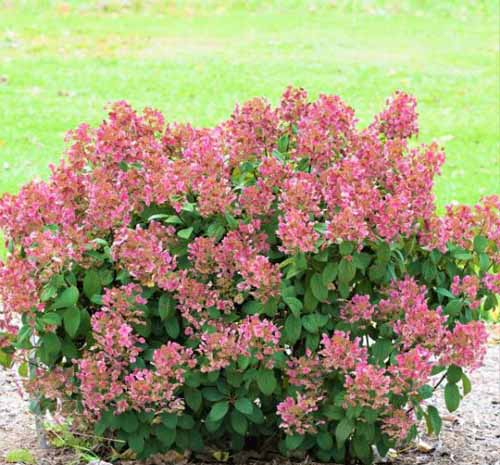

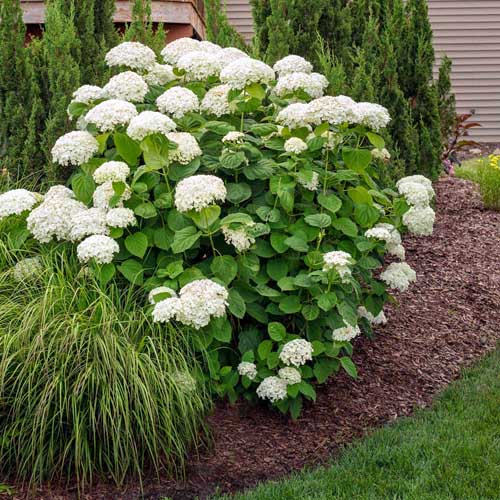
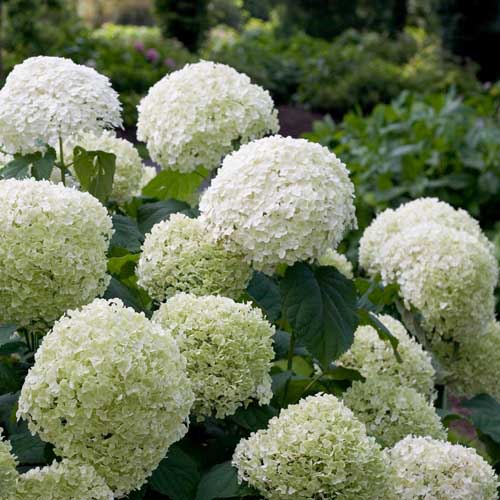
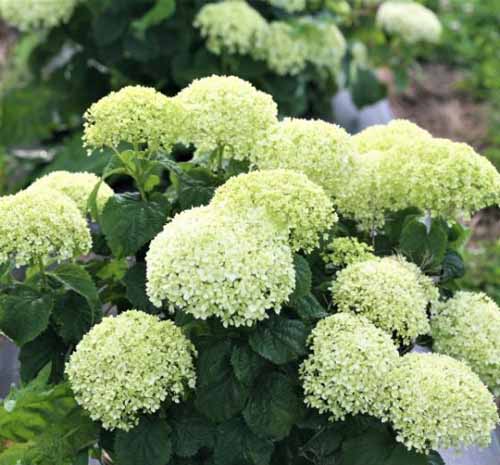
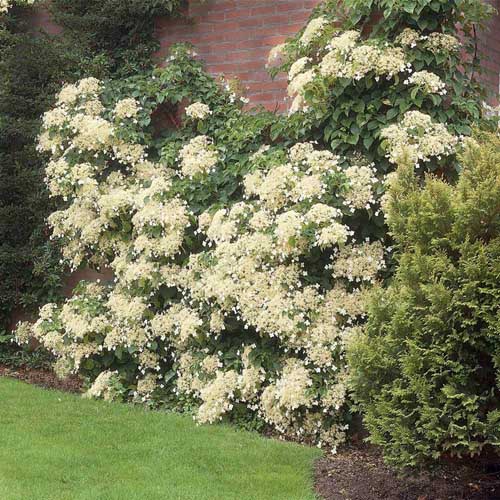
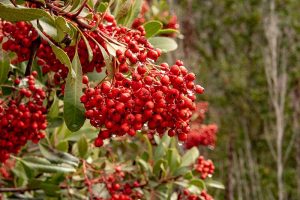
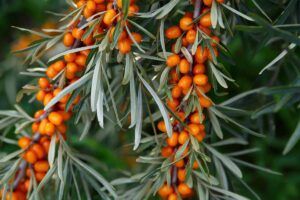
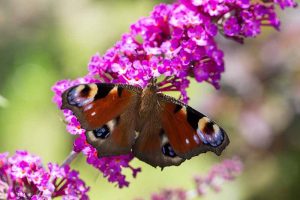
Hi Nan, Thank you for this great article about hydrangeas. I am trying to decide on the right blue hydrangea plant for my garden and would love to get your advice. I love the large blue globular shaped flowers of Nikko Blue and Endless Summer, but wonder how well they will do in a north facing spot that only gets limited direct sunlight (just a few hours a day, with some sections not getting any direct sunlight). Also, the soil is generally moist and does not drain very well. Is there a different variety (but similar to the look of… Read more »
Hello Zev –
We’re so glad you enjoyed the article. While hydrangeas like moisture, shady areas that stay wet can put plants at risk for fungal conditions and rotting. Perhaps you can find a brighter location that drains well for your favorite blue varieties?
Hi Nan,
Your article on hydrangeas has been so helpful. Could you please answer a question for me?
Do you think that a hydrangea with a zone limit of 9 might be okay in zone10? I live in Southern California, the spot I wanted to plant in is on the side of the house gets full sun in the morning ,
and the rest of the day it is very bright but no direct sun. The ground drains well and does not stay wet..
Any advice you could give me would be greatly appreciated.
Thank you,
Hi Nancy –
It is quite possible for a hydrangea with a zone 9 limit to thrive well in your zone 10 location. You may want to consult a local nursery for a second opinion, but with full morning sun and well-draining soil, I would be inclined to give it a try. Be sure to maintain even moisture, but don’t oversaturate. We can’t wait to hear the results.